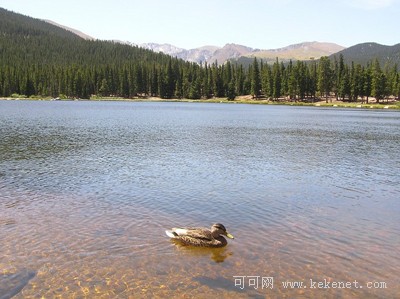(单词翻译:单击)
听力原文
听完了上一期的文章,大家有没有做好实地去落基山中走一走的准备,然后,会有什么样的发现在等着我们呢?值得期待~~ Daisy小编我可是充分准备了去落基山探宝的准备。闲话少说 :-) Let's Go!
But there is more to these rocks than fine acoustics. These rocks tell the story of how the Rocky Mountains were made. The story begins with a mystery. 8,000 feet high in the Colorado Rockies, 60 miles northwest of Boulder, all kinds of strange impressions are found in rocks scattered over the landscape.
We find more than 100 species of marine animals right here at this site. We find sharks, we find lobsters, crabs. We find beautiful fossil clams which are all over the place.
These fossils are crucial evidence of what existed here before the Rockies emerged.
We are sitting at about 8,000 feet in the middle of the Rocky Mountains. And so when these fossils were formed, this was below the level of the ocean. This was below sea level.
This area was covered by a vast inland sea. It existed for over 30 million years and stretched from Utah to Missouri and from the Gulf of Mexico to the Arctic Sea.
And at this very site, it would have been very warm, almost tropical. And so envision, maybe, a day on the beach in Florida, or something like that.
This warm climate attracted a unique type of creature that left behind large, round imprints in the rocks. These fossils would play an important part in the investigation.
This fossil here is a giant fossil ammonite, and this animal, this coiled shell right here, is a relative of modern day squids. So the closest marine relatives today are squids, nautiloids, octopuses things like that. And so in this big coiled shell here, the animal would have lived at this end as tentacles would have stretched out right here. And this animal is really quite remarkable. It is about the size of a truck tyre. And this is incredible because most ammonites aren't this big.
Nowhere else have scientists found a greater number of these prehistoric creatures than here. Miller has come up with a theory why so many of them came to this area.
We think this particular fossil here was a female ammonite. And we think that in part because male squids are smaller than female squids by a lot. So just looking around the fossil deposits here, we found a male ammonite, the small one here. So compare the size of this guy, there is a very big one here. And when we look across this landscape, we find mostly these big ammonites. And so we think that maybe all these females got together to spawn, and then died after they spawned.
小编有约:该大家发言啦!能告诉我,今天咱们最大的发现是什么?
A. prehistoric creatures B. particular fossil C. A theory
根据Daisy的三个线索你知道答案了吗?
听力答案
答案就是"ammonite" 菊石化石。 这可是考古的重大发现,有了它可以有力地向人们证明了在落基山脉形成之前这儿的情况。
参考译文
但是让人惊奇的是这儿的石头有着比剧场的音质还要好的音响,以此诉说着落基山脉形成的故事。故事开头是一团迷雾。在那科罗拉多洛基山高达8,000英尺的山中,在那博尔德西北部延绵60英里的丛林中,各种各样奇形怪状的风景都可以在这堆岩石中找到。
我们发现100多种海洋动物曾经生活在这里,有鲨鱼,龙虾和螃蟹。同时这儿到处都是美丽的蛤化石。
这些化石有力地向人们证明了落基山脉形成之前的情况。
我们正坐在约8000英尺高的落基山脉中间。因此,形成这些化石的时候,这下面都是海洋。也就是在海平面以下。
这个区域覆盖了广阔的内陆海。在这里的时间至少超过了30万年,从犹他州一直到密苏里州以及从墨西哥湾延伸至北冰洋。
而在今天这个位置,也许很热,几乎就是热带地区。因此设想一下,也许,就像在佛罗里达州的沙滩上一样,或者类似的天气 。
这种温暖的气候吸引了一种独特的生物,可以在岩石上看到又大又圆的印记。这些化石将在调查中发挥着重要的作用。
这儿的化石是古代的菊石化石。它是一种盘旋壳的动物,也是现代鱿鱼类动物们的亲属。因此在今天最接近于它的海洋生物有鱿鱼,鹦鹉螺目动物,章鱼等等类似这样的海洋动物。所以,在这个大的盘绕壳中,这些动物居住在此,触手会从壳中伸出。这种动物真的是相当了不起的。它们的体积相当于一个卡车轮胎的大小。不可思议的是大多数菊石并没有这么大。
科学家还没有发现一个比这里具有更多这种史前生物的地方。米勒设想出一种理论,为什么会有许多生物来到这个地方。
我们猜想在这儿的特殊化石是雌性的石菊。之所以这样想,有一部分原因是男性鱿鱼比女性鱿鱼小很多。所以只需要看看在这儿附近的化石沉淀物,不难发现会有小些的化石,应该就是雄性菊石。比较比较这些家伙们的大小,就会发现有一个非常大的菊石。俯瞰这些景象时,我们发现大多数是一些大菊石。由此,我们设想,也许所有这些女性菊石聚在一起产卵,等它们孵出卵后,就相继死去。
重点讲解
注释:①acoustics n. 声学;音响效果,音质
例句:
1. The hall has good acoustics.
这个大厅音响效果好。
2. The acoustics is a branch of physical.
声学是物理学的一个分支。
②scatter vi. 分散,散开;散射 vt. 使散射;使散开,使分散;使散播,使撒播
n. 分散;散播,撒播 vi.分散,散开;[军]散射
例句:
1. It is a lute to scatter songs to his mistress.
它是一只琵琶,向他的情侣弹奏爱恋的心曲。
2. She tripped on a scatter rug.
她被小块地毯绊倒了。
③crucial adj. 重要的;决定性的;定局的;决断的
例句:
1. Salt is a crucial ingredient in cooking.
盐是烹调的一种重要材料。
2. Negotiations were at a crucial stage.
谈判正处于一个关键的阶段。
句子讲解:
1. We find more than 100 species of marine animals right here at this site. We find sharks, we find lobsters, crabs. We find beautiful fossil clams which are all over the place.
【结构简析】这里用了3个"We find " 句子来说明我们在落基山中找到的东西,有层层递进的意味在这里,从很广泛的海洋生物到鲨鱼、龙虾再到蛤化石。
【参考译文】我们发现100多种海洋动物曾经生活在这里,有鲨鱼,龙虾和螃蟹。同时这儿到处都是美丽的蛤化石。
2. Nowhere else have scientists found a greater number of these prehistoric creatures than here.
【结构简析】这里用了一个倒装句,来阐述科学家们的重大发现。
【参考译文】科学家还没有发现一个比这里具有更多这种史前生物的地方。



